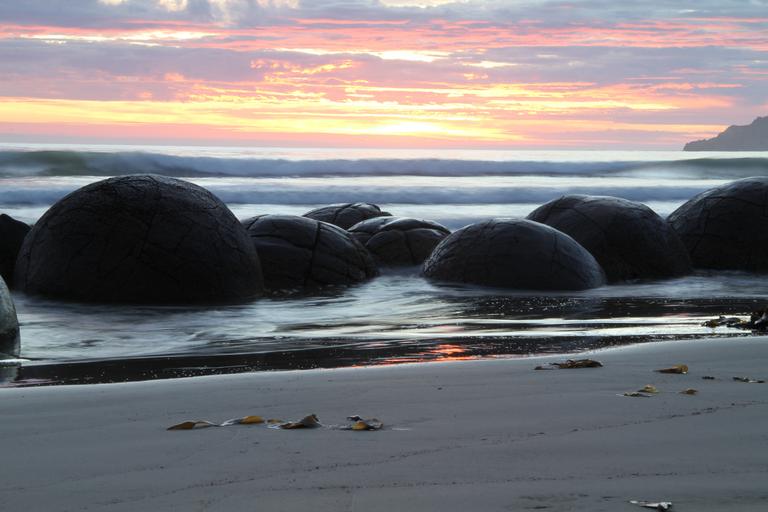MAKE A MEME
View Large Image

| View Original: | Moeraki_Boulders_at_Dawn.jpg (5184x3456) | |||
| Download: | Original | Medium | Small | Thumb |
| Courtesy of: | www.flickr.com | More Like This | ||
| Keywords: outdoor The Moeraki Boulders are unusually large and spherical boulders lying along a stretch of Koekohe Beach on the wave-cut Otago coast of New Zealand between Moeraki and Hampden. They occur scattered either as isolated or clusters of boulders within a stretch of beach where they have been protected in a scientific reserve. The erosion by wave action of mudstone, comprising local bedrock and landslides, frequently exposes embedded isolated boulders. These boulders are grey-colored septarian concretions, which have been exhumed from the mudstone enclosing them and concentrated on the beach by coastal erosion. The most striking aspect of the boulders is their unusually large size and spherical shape, with a distinct bimodal size distribution. Approximately one-third of the boulders range in size from about 0.5 to 1.0 metre (1.6 to 3.3 ft) in diameter, the other two-thirds from 1.5 to 2.2 metres (4.9 to 7.2 ft). Most are spherical or almost spherical, but a small proportion are slightly elongated parallel to the bedding plane of the mudstone that once enclosed them. The rock comprising the bulk of a boulder is riddled with large cracks called septaria that radiate outward from a hollow core lined with scalenohedral calcite crystals. en.wikipedia.org/wiki/Moeraki_Boulders en.wikipedia.org/wiki/Dawn The Moeraki Boulders are unusually large and spherical boulders lying along a stretch of Koekohe Beach on the wave-cut Otago coast of New Zealand between Moeraki and Hampden. They occur scattered either as isolated or clusters of boulders within a stretch of beach where they have been protected in a scientific reserve. The erosion by wave action of mudstone, comprising local bedrock and landslides, frequently exposes embedded isolated boulders. These boulders are grey-colored septarian concretions, which have been exhumed from the mudstone enclosing them and concentrated on the beach by coastal erosion. The most striking aspect of the boulders is their unusually large size and spherical shape, with a distinct bimodal size distribution. Approximately one-third of the boulders range in size from about 0.5 to 1.0 metre (1.6 to 3.3 ft) in diameter, the other two-thirds from 1.5 to 2.2 metres (4.9 to 7.2 ft). Most are spherical or almost spherical, but a small proportion are slightly elongated parallel to the bedding plane of the mudstone that once enclosed them. The rock comprising the bulk of a boulder is riddled with large cracks called septaria that radiate outward from a hollow core lined with scalenohedral calcite crystals. en.wikipedia.org/wiki/Moeraki_Boulders en.wikipedia.org/wiki/Dawn | ||||